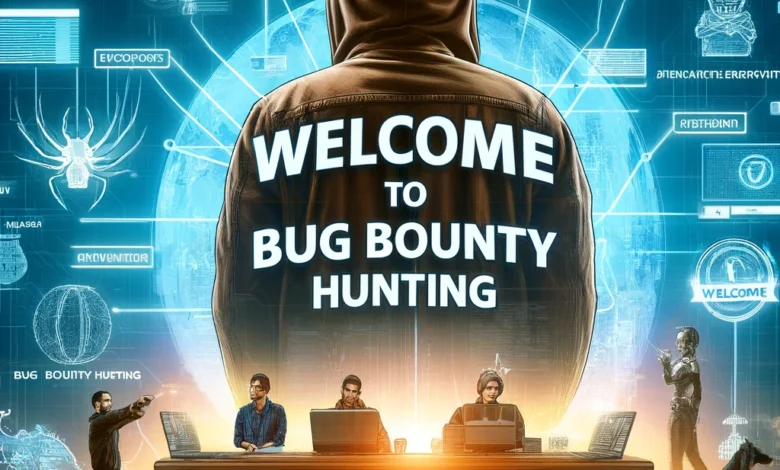Beginner’s Guide to Bug Bounty Hunting: Start Your Cybersecurity Journey
Step into the World of Ethical Hacking and Secure Digital Frontiers

Introduction to Bug Bounty Hunting
Welcome to the thrilling frontier of cybersecurity, where the keen minds of ethical hackers play a crucial role in fortifying our digital world. This introduction serves as your first step into the dynamic realm of bug bounty hunting—a journey that not only challenges your technical skills but also offers the chance to contribute significantly to online safety. As we embark on this adventure, let’s unravel the essence of bug bounty programs, trace their evolution, and discover the symbiotic relationship they foster between cybersecurity enthusiasts and the corporate world.
What Are Bug Bounty Programs?
A bug bounty program is an open invitation from companies and organizations for cybersecurity experts and ethical hackers to identify and report vulnerabilities in their software, websites, and systems. Contributors are rewarded in return for these valuable insights, which could potentially save companies from severe security breaches and financial losses. These rewards can range from monetary compensation to public recognition and career opportunities, depending on the severity of the vulnerabilities uncovered and the policies of the hosting entity.
The Historical Context and Growth
The concept of bug bounties is not new; it has roots that stretch back to the early days of the Internet. However, the formalization of these programs began to take shape in the late 1990s and early 2000s, with pioneering companies recognizing the benefits of crowd-sourced security testing. Since then, the popularity and acceptance of bug bounty programs have soared, evolving from niche initiatives to a vital component of cybersecurity strategies for organizations worldwide. This growth reflects an increasing acknowledgment of the complexities of digital threats and the understanding that safeguarding digital assets requires a collaborative effort.
Mutual Benefits for Hackers and Companies
The beauty of bug bounty programs lies in their mutually beneficial nature. For ethical hackers, these programs offer a platform to hone their skills, gain recognition, and earn rewards in a legal and structured environment. It’s a unique space where emerging talents can make a name for themselves, and seasoned professionals can challenge their expertise against some of the most fortified digital fortresses.
For companies, the advantages are manifold. Beyond the obvious benefit of identifying and mitigating vulnerabilities before they can be exploited maliciously, these programs enable access to a global pool of talent. This diversity in perspective and technique enhances the effectiveness of security measures, promoting a more resilient digital infrastructure. Furthermore, engaging with the bug bounty-hunting community helps build a positive security posture, demonstrating a commitment to proactive defense measures.
As we delve deeper into the world of bug bounty hunting, remember that this journey is as much about personal growth and learning as it is about contributing to a safer internet. Whether you’re just starting out or looking to expand your expertise, the path of ethical hacking offers endless opportunities to challenge yourself, make a difference, and embark on an exciting cybersecurity adventure.
The Significance of Bug Bounties in Cybersecurity
In cybersecurity’s vast and ever-evolving landscape, bug bounty programs have emerged as pivotal elements in organizations’ defense strategies worldwide. Their significance cannot be overstated, as they leverage the collective expertise of the global cybersecurity community to uncover vulnerabilities that might otherwise remain unnoticed. Through real-world examples and compelling statistics, this section will shed light on the transformative impact bug bounty programs have on enhancing digital security, safeguarding user data, and fostering a culture of proactive cybersecurity measures.
Uncovering Hidden Vulnerabilities
One of the most compelling arguments for the significance of bug bounty programs is the history of critical vulnerabilities that have been discovered and resolved through these initiatives. For instance, the Heartbleed bug, a severe vulnerability in the OpenSSL cryptographic software library, was uncovered thanks to the diligent efforts of ethical hackers. This bug exposed millions of websites to data theft, highlighting the necessity of vigilant security practices. Similarly, the discovery of the Spectre and Meltdown vulnerabilities in modern processors underscored the potential for catastrophic security breaches at the hardware level, which bug bounty programs helped to mitigate.
These discoveries are not mere anomalies but a testament to the critical role that ethical hackers play in the cybersecurity ecosystem. By identifying and reporting these vulnerabilities, bug bounty hunters enable companies to patch potential security flaws before they can be exploited by malicious actors, thereby protecting countless users from data breaches and cyber attacks.
Statistical Insights into the Growth and Impact of Bug Bounties
The growing importance of bug bounty programs is further underscored by statistics that reflect their expanding scope and impact. According to recent reports, the bug bounty industry has seen a significant increase in participation and payouts over the last few years. For example, a leading bug bounty platform reported that the total bounties paid out to ethical hackers surpassed $100 million, a milestone that illustrates the financial commitment of companies to secure their digital assets.
Moreover, the diversity of industries adopting bug bounty programs—from technology and finance to government and healthcare—demonstrates their universal recognition as an essential component of cybersecurity strategy. This widespread adoption highlights the critical nature of these programs and encourages broader participation from the ethical hacking community, further strengthening the collective security posture.
The Proactive Approach to Cybersecurity
Bug bounty programs represent a shift from reactive to proactive cybersecurity measures. By actively seeking out potential vulnerabilities, organizations can prevent security incidents before they occur, rather than responding to them after the fact. This proactive approach mitigates the risk of data breaches and cyber-attacks and promotes a culture of continuous improvement and vigilance within the cybersecurity community.
In conclusion, bug bounty programs’ significance in enhancing digital security is multifaceted, encompassing the discovery of critical vulnerabilities, the protection of user data, and the promotion of a proactive cybersecurity culture. Through the collective efforts of ethical hackers and organizations worldwide, bug bounty programs continue to play a critical role in shaping a safer digital future for all.
Skills and Tools of the Trade
Embarking on the journey of bug bounty hunting requires not just a keen interest in cybersecurity but a solid foundation in various technical skills and an arsenal of tools that aid in discovering and reporting vulnerabilities. This section aims to guide beginners through the essential skills and tools necessary to start their journey in bug bounty hunting effectively. As you dive into this exciting field, remember that learning never stops—the landscape of cybersecurity is continually evolving, and so too must your skills and knowledge.
Essential Skills
- Web Application Security: A significant portion of bug bounty programs focuses on web applications, making understanding web application security paramount. Familiarize yourself with the OWASP Top 10, which lists web applications’ most critical security risks. Learning about SQL injection, cross-site scripting (XSS), cross-site request forgery (CSRF), and other common vulnerabilities will provide a strong base from which to start.
- Common Programming Languages: While you don’t need to be an expert programmer to succeed in bug bounty hunting, a basic understanding of languages such as JavaScript, Python, PHP, and SQL can be incredibly beneficial. Knowledge of these languages helps understand the logic of applications, write scripts to automate tasks, and identify potential security issues in the code.
- Network Security: Understanding the basics of network security is crucial, as vulnerabilities can also exist at the network level. Familiarity with concepts such as port scanning, packet analysis, and using VPNs for anonymity can enhance your ability to discover a broader range of vulnerabilities.
- Cryptography: A basic understanding of cryptographic principles and their application in securing data and communications is beneficial. This includes knowledge of SSL/TLS, hashing algorithms, and encryption techniques.
Essential Tools and Platforms
- Reconnaissance Tools: Tools like Nmap for network scanning, Burp Suite for web application analysis, and Wireshark for packet analysis are indispensable for identifying potential entry points and vulnerabilities.
- Automated Scanners: While automated scanners should not be relied upon exclusively, they can serve as a starting point for identifying common vulnerabilities. Tools such as OWASP ZAP and Nessus can save time in the initial stages of exploration.
- Platforms for Practice: Before jumping into live bug bounty programs, platforms like Hack The Box, PortSwigger Web Security Academy, and OWASP Juice Shop offer safe environments to practice your skills and learn new techniques without the risk of legal repercussions.
- Documentation and Reporting Tools: Detailed notes of your findings are crucial for submitting bug reports. Tools like Joplin, CherryTree, or even a simple markdown editor can help organize your research, evidence, and reproduction steps.
Remember, the successful bug bounty hunter’s toolbox is not just filled with software and scripts but is complemented by a mindset of curiosity, persistence, and ethical integrity. As you build your skillset and select your tools, focus on understanding how and why things work, not just on finding vulnerabilities. This approach will make you a successful bug bounty hunter and a respected member of the cybersecurity community.
Choosing Your Hunting Grounds
As you ready your skills and tools for the exciting world of bug bounty hunting, one of the most crucial decisions you’ll face is selecting where to focus your efforts. The “hunting grounds” you choose can significantly influence your learning curve, success rate, and the rewards you reap. This section aims to guide you through navigating the myriad of bug bounty platforms and choosing targets that align with your skills, interests, and goals.
Popular Bug Bounty Platforms
The landscape of bug bounty platforms is vast, with several key players offering a wide range of programs from companies across the globe. Here are some of the most prominent platforms you should consider:
- HackerOne: One of the largest and most well-known platforms, HackerOne hosts various programs for startups and Fortune 500 companies. It’s an excellent place to start, with a user-friendly interface and resources for beginners.
- Bugcrowd: Offering a similar breadth of programs as HackerOne, Bugcrowd distinguishes itself with a focus on community engagement and education, making it another top choice for those new to the scene.
- Synack: Synack provides a more curated experience, requiring hackers to pass a vetting process before accessing their Red Team programs. This platform is suited for those with experience looking to take on more challenging tasks.
- Cobalt.io: Focused on pentest as a service, Cobalt.io offers a unique model that combines traditional penetration testing with the crowd-sourced bug bounty approach. This platform is ideal for those with a strong foundation in security assessment methodologies.
Tips on Choosing Programs
- Align With Your Skills: Look for programs that match your current skill set. If you’re proficient in web application security, start with those targets. You can expand into other areas like mobile or network security as you grow.
- Read the Rules: Every program has its own rules and scope. Make sure you understand what is expected and what is off-limits to avoid any potential conflicts.
- Consider the Rewards: While it’s not all about the money, the reward structure of a program can indicate the level of difficulty and competition. Starting with programs that offer smaller rewards can mean less competition and a higher chance of success.
- Look for Active Programs: Programs that actively engage with their hunters and have a history of prompt payouts are more rewarding to work with. Check the platform’s forums and social media for feedback from other hunters.
Starting with Less Competitive Targets
- Focus on New Programs: Newly launched programs might not have as many eyes on them, giving you a better chance to find unreported vulnerabilities.
- Target Less Popular Technologies: While many hunters flock to mainstream web applications, consider looking into less common technologies or niche areas. These can include IoT devices, hardware interfaces, or specific software applications that you might have more experience with.
- Engage with the Community: Participating in forums and social media groups related to bug bounty hunting can provide insights into which programs are currently underexplored and potentially lucrative.
Selecting your hunting grounds wisely can significantly impact your bug bounty hunting journey. It’s about finding the right balance between challenge, interest, and reward. As you progress, keep pushing your boundaries, exploring new platforms, and tackling more complex vulnerabilities. The world of bug bounty hunting is vast and varied, offering endless opportunities for those willing to explore.
Setting Up Your Hunting Environment
Embarking on the bug bounty journey requires not just the right skills and a strategic choice of platforms but also a tailored environment that enhances your efficiency and effectiveness. Creating a conducive hunting environment involves careful consideration of hardware, software, virtual machines, and the overall workspace setup. This section provides recommendations to help you establish a robust and distraction-free environment tailored to the unique needs of bug bounty hunting.
Hardware Recommendations
- Powerful Processor: A fast processor (i.e., Intel i5/i7/i9 or AMD Ryzen equivalent) will ensure you can run multiple tools and virtual machines simultaneously without lag.
- Ample RAM: You need at least 16GB of RAM to comfortably handle running multiple applications, with 32GB or more being ideal for more intensive tasks.
- Sufficient Storage: Solid-state drives (SSDs) are recommended for faster boot times and quick program loading. A capacity of 512GB or more allows ample space for tools, virtual machines, and data.
- Multiple Monitors: Having at least two monitors can significantly improve your productivity by allowing you to monitor processes on one screen while researching or documenting findings on another.
Software and Tools
- Operating System: Most bug bounty hunters prefer Linux distributions like Kali Linux or Parrot Security for their pre-installed cybersecurity tools. However, your choice should align with your comfort level and the specific targets you aim to test.
- Security Tools: Familiarize yourself with and install essential security tools such as Nmap, Wireshark, Burp Suite, Metasploit, and OWASP ZAP, among others. Customization and mastery of these tools are key to effective hunting.
- Virtual Machines: Software like VMware or VirtualBox allows you to utilize virtual machines (VMs) to create isolated environments for testing and simulate different operating systems and configurations.
Creating a Secure Environment
- Use VPNs: A Virtual Private Network (VPN) is essential for maintaining anonymity and protecting privacy while conducting research.
- Data Encryption: Ensure that all sensitive data on your devices is encrypted. Utilize disk encryption features available in your operating system to secure your findings and personal information.
- Regular Backups: Establish a routine for backing up your data. This practice protects against data loss due to hardware failure, accidental deletion, or cyberattacks.
Crafting a Distraction-Free Workspace
- Ergonomics: Invest in a comfortable chair and desk setup. Proper ergonomics can reduce fatigue and increase your focus over long hunting sessions.
- Minimize Distractions: Keep your workspace clutter-free and minimize potential distractions. Consider using productivity tools or apps that help block distracting websites during work hours.
- Lighting: Ensure your workspace is well-lit to reduce eye strain. Natural light is ideal, but if not available, use ample indoor lighting that illuminates your workspace evenly.
Setting up a dedicated and optimized environment for bug bounty hunting not only enhances your efficiency but also makes the process more enjoyable. By investing in the right tools, securing your digital space, and creating a physical workspace that supports focus and comfort, you lay down the foundation for a successful and rewarding journey in the realm of ethical hacking.
Your First Bug Report: From Discovery to Disclosure
Congratulations on making it to this pivotal stage of your bug bounty hunting journey—preparing to report your first bug. This process is not just about pointing out flaws; it’s an exercise in clear communication, ethical responsibility, and contributing to the digital safety of users worldwide. This section will guide you through the discovery of vulnerabilities, documenting your findings, considering the ethical implications, and submitting a report that stands the best chance of being well-received.
Discovering Vulnerabilities
- Leverage Your Tools and Skills: Apply the skills and tools you’ve acquired to scan, probe, and test your target within the agreed scope. Stay patient and persistent; finding significant vulnerabilities can take time.
- Stay Organized: Keep detailed notes of your testing process, including the tools used, commands run, and the responses received. This documentation will be invaluable when you prepare your report.
- Verify Your Findings: Before you even think of reporting, ensure that the vulnerability you’ve identified is real, reproducible, and within the scope of the bug bounty program. Double-checking can save you and the program’s maintainers time and effort.
Documenting Your Findings
- Be Clear and Concise: When documenting your findings, clarity is key. Describe the vulnerability, how you discovered it, and its potential impact in straightforward language.
- Provide Evidence: Screenshots, logs, and code snippets can significantly strengthen your report. They provide tangible proof of your findings and help the maintainer understand the issue.
- Include Reproduction Steps: Offer a step-by-step guide on how to reproduce the vulnerability. The easier you make it for the program’s security team to see the issue, the more seriously your report will be taken.
Ethical Considerations
- Respect Privacy: If your testing involves personal data, ensure you handle it with the utmost respect for privacy. Never exploit a vulnerability beyond what’s necessary to prove its existence.
- Stay Within Scope: Adhere strictly to the program’s guidelines. Reporting vulnerabilities outside the agreed scope can have legal implications and damage your reputation in the community.
- Be Patient: Once you’ve submitted your report, give the organization time to respond. Bombarding them with messages can be counterproductive.
Submitting Your Report
- Follow the Template: Many programs provide a template or specific guidelines for submitting reports. Use these to structure your report, ensuring all required information is included.
- Highlight the Impact: Emphasize the potential impact of the vulnerability. If you can show how it might be exploited maliciously, do so in a responsible manner. This can help prioritize the issue.
- Offer Solutions: If possible, suggest ways to mitigate or fix the vulnerability. While this isn’t always expected, it can demonstrate your commitment to improving security.
Your first bug report is a significant milestone in your bug bounty hunting career. By approaching it with diligence, ethical integrity, and a focus on constructive contribution, you’re not just earning potential rewards; you’re also building a reputation as a skilled and responsible security researcher. Remember, the goal is to make the digital world safer for everyone, and your report is a vital step in that process.
Building Your Reputation and Network
In the realm of bug bounty hunting, your reputation and network are invaluable assets that can significantly enhance your opportunities and success rate. This journey is not just about identifying vulnerabilities; it’s also about being part of a community that values collaboration, sharing knowledge, and ethical hacking practices. This section aims to provide guidance on how you can actively engage with the bug bounty community, build a positive reputation, and connect with both peers and industry leaders.
Engaging with the Bug Bounty Community
- Participate in Forums and Platforms: Platforms like HackerOne and Bugcrowd have vibrant communities where hunters discuss vulnerabilities, share tips, and offer support. Actively participating in these forums can help you gain insights, stay updated on the latest trends, and make your name known.
- Contribute to Open Source Projects: Contributing to security-related open source projects is a great way to demonstrate your skills, help others, and improve your visibility in the community. It’s also an excellent way to give back and learn from collaborative development.
- Write Blog Posts or Create Content: Sharing your experiences, tips, or write-ups on discovered vulnerabilities (after they’ve been resolved) can not only help others but also showcase your expertise. Platforms like Medium, personal blogs, or YouTube are great outlets for such content.
Attending Conferences and Meetups
- Security Conferences: Conferences like DEF CON, Black Hat, and various regional BSides events offer invaluable opportunities to learn from sessions, workshops, and meet experts in the field. These events are also excellent for networking and discovering the latest in cybersecurity.
- Local Meetups: Joining local cybersecurity meetups or bug bounty groups can provide a more intimate setting for sharing experiences and connecting with fellow hunters in your area. These gatherings can often lead to collaborations and friendships.
Using Social Media to Connect
- LinkedIn: A professional profile on LinkedIn can help you connect with industry leaders, discover job opportunities, and participate in professional discussions. Regularly sharing your achievements and insights can attract positive attention from companies and peers. Additionally, joining groups and following pages related to cybersecurity and bug bounty hunting, including BugBustersUnited, can provide you with a wealth of resources and community support tailored to both beginners and experts in the field.
- Twitter: Many cybersecurity professionals and ethical hackers are active on Twitter, making it a vital platform for real-time news, discussions, and networking. Following and engaging with key figures in the industry, as well as joining conversations around popular hashtags, can open up avenues for collaboration and mentorship. Don’t forget to follow BugBustersUnited for the latest in bug bounty hunting insights, tips, and community highlights.
- BugBustersUnited: A newcomer to the social media scene but rapidly gaining traction, BugBustersUnited is specifically designed for the bug bounty community. It’s an excellent place for beginners and experts alike to come together, share thoughts, and learn new things about bug bounty hunting. The platform focuses on fostering a supportive environment where members can share knowledge, discuss challenges, and celebrate successes. By participating in BugBustersUnited, you can gain access to a focused community that is passionate about cybersecurity, share your experiences, ask questions, and connect with peers who are eager to share their knowledge and insights.
Leveraging these platforms can significantly enhance your learning experience, expand your professional network, and keep you informed of the latest trends and opportunities in the bug bounty hunting world.
Building a Positive Reputation
- Be Ethical and Professional: Always adhere to the ethical guidelines of bug bounty hunting. Respect the rules of engagement, report vulnerabilities responsibly, and communicate professionally with program owners.
- Be Patient and Persistent: Building a reputation takes time and consistent effort. Don’t be discouraged by initial setbacks; every successful hunter has faced challenges. Your persistence and dedication will pay off in the long run.
- Help Others: Whether it’s through answering questions, offering advice, or sharing resources, helping others can significantly boost your standing in the community. It’s a way to demonstrate your knowledge, foster goodwill, and contribute to the collective security posture.
Engaging actively with the bug bounty community, building a network of peers and mentors, and establishing a positive reputation are key components of a successful bug bounty hunting career. These elements not only enhance your personal growth and opportunities but also contribute to a safer and more secure digital world.
Embarking on Your Journey
As we wrap up our guide, it’s clear that the path of bug bounty hunting is both challenging and rewarding. You stand at the threshold of an adventure that not only promises personal and professional growth but also the opportunity to make a significant impact on the cybersecurity landscape. BugBustersUnited is here to support you as you take these first steps, offering guidance, resources, and a community to help you navigate this journey.
The Courage to Begin
Beginning anything new can be daunting, especially in a field as complex and dynamic as cybersecurity. Remember, every expert was once a beginner. Your curiosity, passion, and willingness to learn are your most valuable assets. Embrace the challenges and setbacks as opportunities to grow stronger and more skilled.
A Journey of Continuous Learning
Bug bounty hunting is an ever-evolving discipline. New technologies, vulnerabilities, and defensive tactics emerge regularly, making continuous learning an integral part of your journey. Stay curious, keep exploring, and never hesitate to dive into new areas. The more you learn, the more you’ll discover your unique strengths and interests within the vast cybersecurity domain.
Living the Ethical Hacker’s Creed
Integrity, respect, and professionalism are the cornerstones of being an ethical hacker. Your actions should always aim to improve security, protect privacy, and prevent harm. Upholding these values not only enhances your reputation but also contributes to the trust and collaboration essential to the bug bounty community.
Your Place in BugBustersUnited
You’re not alone on this journey. BugBustersUnited is more than a platform; it’s a community of like-minded individuals united by a common goal: to secure the digital world, one bug at a time. Here, you’ll find support, inspiration, and the collective wisdom of fellow bug bounty hunters. We encourage you to engage, share your experiences, and grow with us.
As you embark on this exciting journey, remember that every step you take is a move towards a more secure digital future. The paths you explore, the challenges you overcome, and the contributions you make all add up to a career that’s not only intellectually fulfilling but also globally beneficial.
Welcome to the world of bug bounty hunting. Welcome to BugBustersUnited. Let the adventure begin.




